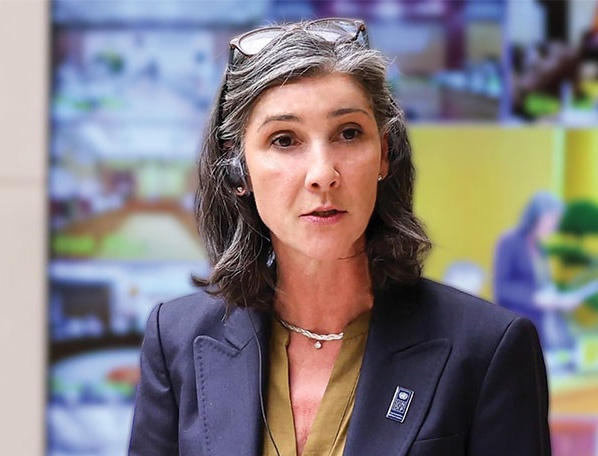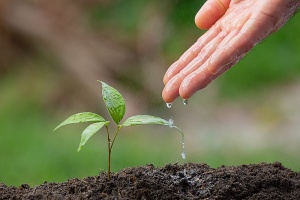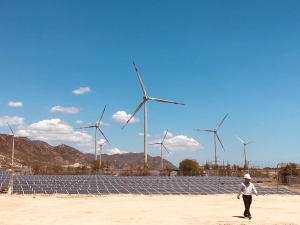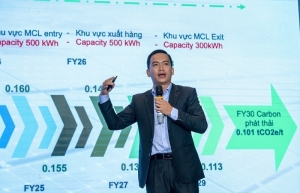Catalysing change for all of society
What is your take on the current global trend of green development today?
 |
| Ramla Khalidi, resident representative of the United Nations Development Programme in Vietnam |
Climate change is increasingly compelling countries to restructure their economies. Daunting as all this may seem, crises can be a catalyst for change. The country parties to the United Nations Convention on Biodiversity have agreed on a new global biodiversity framework at the 15th Conference of the Parties in December in Canada, aiming to conserve biodiversity and natural resource, upon which the global economies and people are dependent.
The trends are moving towards green growth. We can transform current challenges into the foundations of a more prosperous and stable future by investing in a green, resilient, and inclusive economy. For example, the world is presently experiencing its first truly global energy crisis. This is happening at a time when the cost of renewables continues to drop.
What was not considered possible only a few years ago is now within reach, thanks to progress in technology and innovation. Vietnam has immense potential for renewable energy, so now is a perfect time to reassess the current trajectory of energy development.
The environment and the economy are fundamentally interconnected. Some argue that the economy is a subset of the environment, since we rely completely on nature to survive. Whether or not you agree, it is nevertheless critical to understand that this is not a zero-sum game where only one can be supported at the expense of the other.
Like what Vietnam has laid out in its Green Growth Strategy, a green economy fosters long-term growth and job creation while tackling health, climate change, and biodiversity issues. While we restructure our economies to make them more sustainable, we are also striving to achieve the UN’ Sustainable Development Goals by 2030. The transition to renewable energy takes place at a time when, around the world, 760 million people still do not have access to electricity. Green growth must also be socially sustainable, including the poor and vulnerable people, women, and people living in rural and remote areas.
How do you see the environmental picture in Vietnam, and what dark areas need to be changed on this issue?
I applaud the Vietnamese government for its proactive response in this transitional period. The new National Climate Change Strategy provides a clear framework for reaching Vietnam’s pledge of net-zero emissions by 2050. Vietnam also updated its Nationally Determined Contributions in 2022 with even more ambitious targets, incorporated the circular economy into its development strategies, and released the National Biodiversity Strategy and Action Plan to 2030.
On the other hand, Vietnam still relies too heavily on fossil fuels. Coal accounts for approximately one-third of total installed capacity, and based on current projections, national generating capacity has to double by 2030. Vietnam must gradually transition to renewables to ensure its own energy security and build a greener industry.
Vietnam’s fast economic growth, rapid urbanisation and industrialisation are imposing increasing pressure on natural resources and environment. We have witnessed large environmental incident as the case of Formosa’s environmental pollution along 200km coastal line in the central region. To realise Vietnam’s ambition of not trading off environment for economic development, more effective law enforcement and transparency are needed.
Vietnam’s wealth of natural resources has also been declining continuously over the past two decades, which has resulted in environmental issues such as air and water pollution, biodiversity and species loss, ecosystem degradation, water insecurity, and resource depletion, not to mention lessening overall contributions to human wellbeing.
The country is working towards creating a greener economy. How should it deploy a green revolution?
The challenges are there, I agree. It will require a whole-of-society and whole-of-industry transformation with considerable upfront capital investment. Technical improvements in recent years have lowered the cost of renewable energy systems to the point at which they are competitive with coal, oil and natural gas. However, renewable energy is more capital-intensive, with high up-front costs and lower maintenance costs. The supply of long-term capital at a reasonable cost is an important constraint in achieving the energy transition.
International finance can help, but the truth is that most of the capital required for the energy transition will be domestic. This conclusion is based on historical trends and developing countries’ economic structure. Around the world, most of the capital invested in renewable energy comes from domestic sources. This is the case in both high-income countries and the developing world.
An important reason is that foreign financing creates foreign currency obligations. There is a limit on the amount of foreign capital – loans and direct investment – that developing countries can absorb without running into balance of payments problems.
International concessional financing can help, but the fact is that most of the capital required for the energy transition will be sourced domestically. Increasing the domestic supply of long-term financing will require policy innovations, including measures to stimulate the development of the corporate bond market and mechanisms to use the government’s balance sheet to share the risk of investment with private operators.
International experience has shown that public development banks can play an important role in mobilising capital, creating new structured finance vehicles and co-investing with commercial banks and international donor agencies to ensure that power generation and energy efficiency projects are socially and financially viable. The UN Development Programme (UNDP) has recommended that the government explore establishing a new public sector climate bank, perhaps in collaboration with international partners and the private sector, to diversify sources of domestic finance for the energy transition and the greening of the economy.
Equally important is green transport that improves mobility, reduces air pollution, and enhances wellbeing. Vietnam needs a strong enabling environment to utilise this potential, which could be one of our greatest chances to support the net-zero transition while offering enormous economic and societal advantages.
Similarly, green living and consumption are both an opportunity and a challenge for Vietnamese businesses. Consumers are becoming more market-savvy and eco-conscious, especially in international markets, demanding lower carbon footprints from the products and services they purchase.
With all this in mind, I think Vietnam would benefit from a “green doi moi,” a trajectory that sustains and regenerates the natural capital on which its people and economy depend. It would set the stage for a just energy transition, simultaneously accelerating renewable energy generation, improving energy efficiency, and protecting the vulnerable.
The Law on Environmental Protection has been in effect for just over a year. Do you think this law has made any outstanding marks?
This law took many important steps, but one of the real highlights is its landmark inclusion of a circular economy. Legally enshrining a definition of circular economy will help to reduce natural resource exploitation, keep more circulating in the economy, and reuse and recycle products in a way that minimises extraction and cuts down on emissions.
The new law is also remarkable in that it has not only defined high-emitting sectors and enterprises but also directed them to implement measures to reduce their emissions, which is a big move towards accountability.
Finally, the law defines a roadmap for developing a carbon market. Imposing a significant price on emissions will promote efficiency gains and new technologies, and potentially generate more climate finance that can be mobilised for climate action.
To achieve net-zero emissions by 2050, Vietnam urgently needs international support. How will the UNDP help with this?
At the national level, our support focuses on policy formulation and enhancement of capacity, while at the sub-national level we are currently implementing a project that will catalyse a sustainable shift towards e-mobility in Vietnam, with support from the Japanese government. This includes the pilot of e-trucks and e-bikes in the central city of Hue.
With support from the Japanese government, we are currently implementing a project that will catalyse a sustainable shift towards e-mobility in Vietnam. At the national level, it focuses on policy formulation and introducing standards, while sub-nationally, we are piloting e-trucks and e-bikes in the central province of Hue. We are also carrying out extensive work on promoting the circular economy, such as supporting policy formulation, training businesses and the private sector, developing community-based models to tackle waste management, sourcing innovative solutions for marine plastic pollution, and launching the Circular Economy Hub, a public-private platform to engage stakeholders across Vietnam in the circular economy transition.
On a broader scale, it is imperative to set forth an agenda in which economic development is recoupled with restoring the ecosystem. Nature-based solutions creatively tackle both biodiversity loss and climate change; funds will have to be strategically channelled into financial solutions such as payments for ecosystem services, nature-based tourism, and private sector contributions. These are all interventions that the UNDP aims to bring forward more strongly in the future.
In the end, transformative change across all parts of our society and economy is needed to stabilise the climate, stop biodiversity loss, and chart a path to the sustainable future we want.
 | EU nations ready to support ASEAN in green development As the European Union and ASEAN strengthen ties via a new biennial trade and investment programme, Vietnam is also closely working with the EU to further cooperation, while the country’s journey to a low-carbon economy is also receiving major assistance from the bloc. |
 | Vietnam to become green manufacturing hub by 2050 through net zero approach Vietnam’s commitment to achieving net zero emissions by 2050 at COP26 is expected to bring a tailwind of opportunities, helping to turn the country into a green manufacturing hub and facilitating the export of made-in-Vietnam products into the markets of developed nations. |
 | Green development: A solution to post-pandemic recovery for businesses At the 2022 Green Economy Forum – with the theme of Post-pandemic Adaptation and Development – in Ho Chi Minh City, all speakers agreed that Green Development is a solution that will coincide with future trends, helping businesses navigate their way out of the pandemic. |
What the stars mean:
★ Poor ★ ★ Promising ★★★ Good ★★★★ Very good ★★★★★ Exceptional
Related Contents
Latest News
More News
- Honda launches electric two-wheeler, expands charging infrastructure (January 12, 2026 | 14:00)
- Vietnam striving to ease air pollution (January 09, 2026 | 14:41)
- Petrovietnam Gas awards first multi‑year LNG deal to Shell (January 09, 2026 | 14:38)
- Advancing the net-zero journey: Carlsberg Vietnam’s sustainability progress in 2025 (January 09, 2026 | 09:49)
- The green hydrogen and ammonia future for Vietnam (January 06, 2026 | 15:03)
- Green transition to close $20 billion annual investment gap (December 31, 2025 | 11:59)
- Australia contributing to Vietnam’s climate change responses (December 30, 2025 | 11:37)
- CME Solar strengthens position in Vietnamese renewables (December 30, 2025 | 11:21)
- Self-care signals shift towards sustainable healthcare (December 30, 2025 | 10:12)
- GreenYellow marks five years of clean energy growth in Vietnam (December 26, 2025 | 15:51)

 Tag:
Tag:


















 Mobile Version
Mobile Version